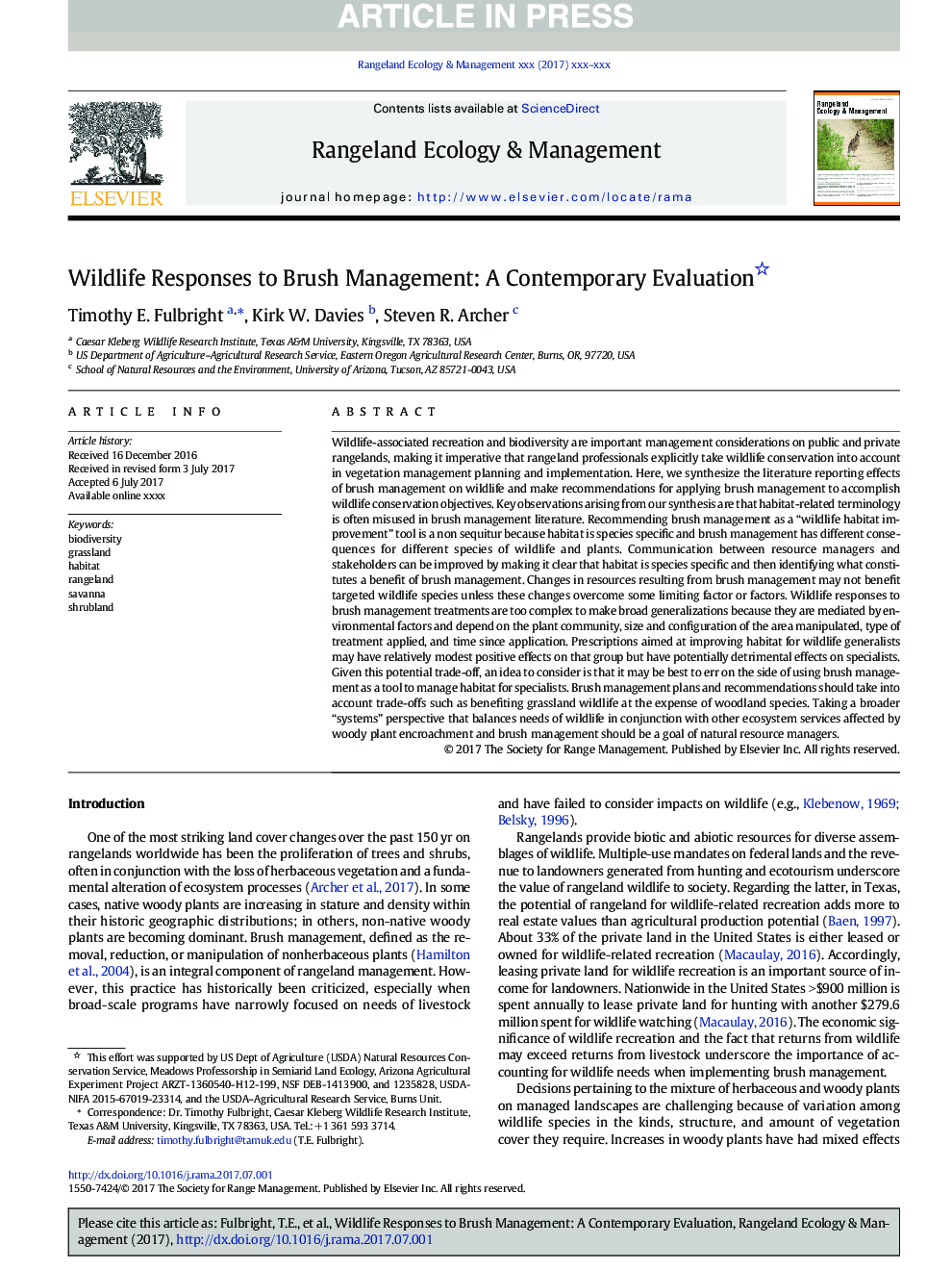| کد مقاله | کد نشریه | سال انتشار | مقاله انگلیسی | نسخه تمام متن |
|---|---|---|---|---|
| 8849636 | 1618646 | 2018 | 10 صفحه PDF | دانلود رایگان |
عنوان انگلیسی مقاله ISI
Wildlife Responses to Brush Management: A Contemporary Evaluation
ترجمه فارسی عنوان
پاسخ های حیات وحش به مدیریت برس: ارزیابی معاصر
دانلود مقاله + سفارش ترجمه
دانلود مقاله ISI انگلیسی
رایگان برای ایرانیان
کلمات کلیدی
تنوع زیستی، چمنزار زیستگاه، مرتع، ساوانا، درختچه
ترجمه چکیده
تفریح و تنوع زیستی مرتبط با حیات وحش، ملاحظات مدیریتی مهم در مراتع عمومی و خصوصی است، و این امر ضروری است که متخصصان مرتع به طور صریح در برنامه ریزی و پیاده سازی مدیریت پوشش گیاهی، به حفاظت از حیات وحش توجه داشته باشند. در اینجا، ما ادبیات اثرات مدیریت برس روی حیوانات وحشی را تهیه می کنیم و توصیه هایی را برای استفاده از مدیریت برس برای رسیدن به اهداف حفاظت از حیات وحش می کنیم. مشاهدات اصلی ناشی از سنتز ما این است که اصطلاحات مرتبط با زیستگاه اغلب در ادبیات مدیریت برس استفاده می شود. توصیه به مدیریت قلم مو به عنوان یک بهبود زیستگاه حیات وحش؟ ابزار یک سری غیر متقابل است زیرا زیستگاه نوع خاصی است و مدیریت برس دارای عواقب مختلفی برای گونه های مختلف حیات وحش و گیاهان است. ارتباط بین مدیران منابع و ذینفعان می تواند با روشن ساختن این که زیستگاه گونه های خاص است و سپس شناسایی آنچه منفعت مدیریت قلم مو است، بهبود می یابد. تغییرات در منابع ناشی از مدیریت برس ممکن است از حیوانات وحشی مورد هدف قرار نگیرد مگر اینکه این تغییرات غلبه بر عوامل یا عامل محدود کننده باشد. واکنش های حیات وحش به درمان های مدیریت برس برای ایجاد تعاریف گسترده بسیار پیچیده هستند زیرا آنها از عوامل محیطی متمایز هستند و بستگی به جامعه گیاه، اندازه و پیکربندی ناحیه دستکاری شده، نوع درمان اعمال شده و زمان اجرا دارد. مقرراتی که با هدف بهبود زیستگاه برای متخصصان حیات وحش می توانند اثرات مثبت مثبتی بر روی آن گروه داشته باشند، اما اثرات بالقوه مضر روی متخصصان دارند. با توجه به این احتمال بالقوه، یک ایده در نظر گرفتن این است که بهتر است در کنار استفاده از مدیریت قلم مو به عنوان یک ابزار برای مدیریت زیستگاه برای متخصصان، اشتباه شود. طرح های مدیریت برس و توصیه ها باید در نظر گرفتن ترکیبات مانند بهره برداری از حیات وحش دام و طیور به هزینه گونه های جنگلی. یک سیستم گسترده تر چشم انداز که نیازهای حیات وحش را در مقایسه با سایر خدمات اکوسیستم که تحت تأثیر قرار گرفتن درگیری های گیاهان چوب قرار گرفته است، مدیریت می شود، باید یک هدف از مدیران منابع طبیعی باشد.
موضوعات مرتبط
علوم زیستی و بیوفناوری
علوم کشاورزی و بیولوژیک
علوم کشاورزی و بیولوژیک (عمومی)
چکیده انگلیسی
Wildlife-associated recreation and biodiversity are important management considerations on public and private rangelands, making it imperative that rangeland professionals explicitly take wildlife conservation into account in vegetation management planning and implementation. Here, we synthesize the literature reporting effects of brush management on wildlife and make recommendations for applying brush management to accomplish wildlife conservation objectives. Key observations arising from our synthesis are that habitat-related terminology is often misused in brush management literature. Recommending brush management as a “wildlife habitat improvement” tool is a non sequitur because habitat is species specific and brush management has different consequences for different species of wildlife and plants. Communication between resource managers and stakeholders can be improved by making it clear that habitat is species specific and then identifying what constitutes a benefit of brush management. Changes in resources resulting from brush management may not benefit targeted wildlife species unless these changes overcome some limiting factor or factors. Wildlife responses to brush management treatments are too complex to make broad generalizations because they are mediated by environmental factors and depend on the plant community, size and configuration of the area manipulated, type of treatment applied, and time since application. Prescriptions aimed at improving habitat for wildlife generalists may have relatively modest positive effects on that group but have potentially detrimental effects on specialists. Given this potential trade-off, an idea to consider is that it may be best to err on the side of using brush management as a tool to manage habitat for specialists. Brush management plans and recommendations should take into account trade-offs such as benefiting grassland wildlife at the expense of woodland species. Taking a broader “systems” perspective that balances needs of wildlife in conjunction with other ecosystem services affected by woody plant encroachment and brush management should be a goal of natural resource managers.
ناشر
Database: Elsevier - ScienceDirect (ساینس دایرکت)
Journal: Rangeland Ecology & Management - Volume 71, Issue 1, January 2018, Pages 35-44
Journal: Rangeland Ecology & Management - Volume 71, Issue 1, January 2018, Pages 35-44
نویسندگان
Timothy E. Fulbright, Kirk W. Davies, Steven R. Archer,
